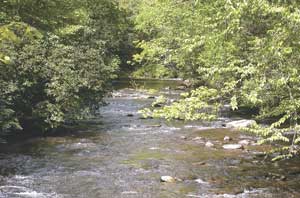
September is a transitional month for trout fishers, a limbo period between summer and autumn when streams are still at summer temperatures and trout are active only during the cooler parts of the day, usually early morning and late evening. Fishing during these times requires patience and finesse. You’ll have to work for every strike you get. Fish have to eat, though; you just have to find their preferred dining spots.
During hot weather, trout prefer the cooler sections of streams where water temperatures are comfortable and oxygen is plentiful. Look for bubbly, white water, places below ledges, cascades and small waterfalls. Drop a fly at the top of a run and let it drift through the riffles. Old-timers referred to this technique as “dabbling.”
Other excellent places to fish are near small feeder streams that dump cooler water into a main stream. Streams with abundant bank cover will have lower water temperatures than open streams, so don’t hesitate to take a side trip into a tributary. You’ll likely catch more fish in these streams than you will in a main stream.
The trout will be small, of course, but they’ll be feisty and worth the effort.
Small streams can be fished all day. Large, open streams should be reserved for early morning and late evening fishing.
Rainfall has been abundant this summer, especially at the Great Smoky Mountains National Park. Stream flow is excellent in most streams, and water levels are normal. Still, finesse is required.
Keep a low profile, make long casts, and use long leaders, at least 9 feet. Cast close to banks and try to place your fly underneath low-hanging mountain laurel and rhododendron bushes.
Anglers will lose a few flies and spend a lot of time getting line and flies out of bushes, but they’ll also hook an occasional big trout.
Hatches are minimal this time of the year, but the old reliables are still coming off. Most common hatches are Light Quill, Light Cahill, Trico, Blue-Winged Olive, and Midges. Summer hatches usually are most abundant at dusk. During overcast days, Blue-Winged Olive hatches occur sporadically all day.
For morning fishing, use Blue-Winged Olives, female or male Adams (winged or parachute), Light Cahills, Light Quills or a parachute Pheasant Tail (recommended sizes are 18 to 14).
Midges are effective during late evening hours. Crème works well but also try black and gray in sizes 22 to 18. Experiment with a pattern and stay with the one that works best.
Nymph patterns usually can be fished all day, but nymph fishing requires skill and patience. Strikes can be subtle and difficult to detect unless one has done a lot of nymph fishing.
Often a strike will be little more than a slight hesitation of the leader. A strike indicator attached to the leader about 2 feet above the fly will give anglers a bit of an edge in detecting a strike. A piece of brightly-colored yarn or a bit of cotton works just as well as a commercial strike indicator.
You also can use a dry fly as an indicator and a nymph as a dropper to help detect strikes. Using a short piece of leader, attach the dropper to the shank of a dry fly such as a Stimulator. The dropper should be at least two sizes smaller than the main fly.
Watch the indicator fly as it floats. If it hesitates or moves to one side or the other, raise the tip of your rod; you’ve likely had a strike. A bonus of this method is occasionally a trout will strike the indicator fly.
Suggested nymph patterns include Brown Stone, Tellico, Sheep Fly, Blue-Winged Olive and Pheasant Tail.
Terrestrials are the work horses of summer fishing.
Bugs are abundant until first frost, and trout love them. Ants, Japanese beetles, crickets, grasshoppers, caterpillars inchworms, ants and bees provide a constant and substantial food source for trout.
Terrestrials may be fished either wet or dry. If you want to get a terrestrial down deep, add a beadhead or small bit of lead to the fly. Fish terrestrials close to banks, near bushes and places where weeds or grass grow along the bank. Use a No. 12 for ants and a No. 10 0r No. 8 for other terrestrials.
Streamers are ideal for fishing after a shower when water is a little dingy and high. Woolly Boogers, Muddler Minnow, Dace, Mickey Finn, and other patterns that simulate swimming aquatic life work well, especially in deep pools where the biggest trout are likely to be. Cast the streamer downstream and strip it back to you.
The N.C. Wildlife Resources Commission does little stocking during late summer. Only a few streams are stocked in August, and no streams are stocked during September.
Streams that are stocked during August include the Toe River in Yancey County, lower Davidson River in Transylvania County, Rocky Broad River in Rutherford County, Wilson Creek in Caldwell County, North Toe River in Avery, Middle Fork of the New River in Watauga County, East Prong of the Roaring River, and the Tuckasegee River in Jackson County.
Two delayed-harvest streams, the East Prong of the Roaring River and Stone Mountain Creek in Wilkes County, were stocked during August. All other delayed-harvest streams will be stocked during October for the opening of the catch-and-release segment of the delayed-harvest season.




Be the first to comment